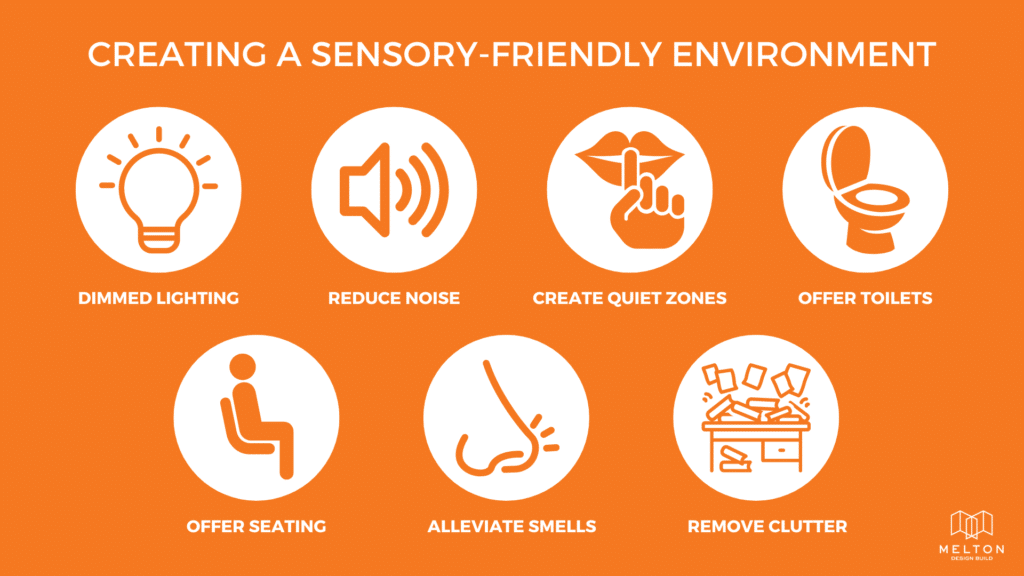Designing and Building Sensory-Friendly Spaces
By Echo & Graham Steers

At their best, our homes can be sources of rejuvenation, restfulness, and restoration—supportive and enabling places where we can be free to embody ourselves wholly. Achieving this ideal requires designing and constructing spaces that consider the needs of all inhabitants. Thankfully there is a wealth of good information out there on universal design as it relates to bodies that move differently through space, and (though it falls short in many aspects) ADA compliance continues to strive to make the physical world more accessible. As a collective, we have so much work to do to make the world more accessible to neurodistinct folks in our community. Now is the moment for us to seriously consider how people navigate the world mentally and sensorily.
When we have family members who are neurodistinct we have an occasion to be more thoughtful in so many aspects of our lives, including our design choices. We get to care for the details, to pay special attention to certain elements based on the unique needs of our loved ones. Thereby we might create a space that gives them the gift of a much-needed break from the stresses of navigating a frequently alienating, often painful external world largely designed for neurotypicals or allistics. Though outside factors (like budget, material, and time constraints) must be accounted for—and can be frustratingly limiting—we still have an opportunity to be creative in cultivating respite for the whole family.


We can thoughtfully construct a haven. We can lovingly build a sensory retreat.
Whether we are considering Autism Spectrum needs, forms of attention deficit, chronic pain or illness, environmental sensitivities, or any other neurodivergence—one common thread can be a different way of processing sensory data in the environment. Thus, the main design principle at play in designing neurominority-friendly, safe spaces is to reduce and simplify the impact on each of the affected senses. Here are a couple of pointers to consider when designing a neurodistinct-safe space, based on recommendations from the Autistic Self Advocacy Network.

Sight
- Ensure all lights are dimmable
- Use diffused, indirect lighting methods such as valances
- No fluorescent lights
- Create clean and simple lines
- Reduce ‘visual noise’ by eliminating clutter; everything has a home
- Lean into earth tones
Sound
- Install a white noise (or, even better, a “pink noise”) machine
- Use sound-dampening insulation in interior walls
- Apply acoustic panels to the studs before drywall
- Hang sound-absorbing and dampening materials on interior walls
Texture
- Touch the flooring materials being proposed to ensure they are comfortable for all members of the family
- Consider smooth drywall finishes
Smell
- Energy Recovery Ventilation/Heat Recovery Ventilation to keep fresh, clean air circulating through the house
- Install HEPA air filters in the space
- Utilize ultraviolet air cleaners
- Use ZeroVOC options when possible to minimize off-gassing odors
Signs
- Set people up for success by making signs in your space that inform visitors of expectations, such as, “No perfumes, please” or “Please speak quietly”
Materials
- Whenever possible, opt for easily sanitized materials
- When gathering materials, take advantage of the sensory-friendly hours offered by some retailers, wherein lights are dimmed, music is off, and traffic is lower
Spatial configuration
- Utilize storage for non-essential items, and rotate as needed
- Subdivide the room and space out the seating
Depending on the particular neuroprocessing characteristics of your family, you may want to incorporate one or a mixture of these suggestions. If we are creative in our approach and willing to forgo mindlessly conforming to convention, we have so many great opportunities to make our homes places where we can all truly be comfortable. “By reworking society to make it more flexible and accommodating of difference,” and when we honor the needs of the neurodistinct among us, “we can improve the mental and physical health of all people” (Devon Price Unmasking Autism 233). After all, “[a] world that embraces neurodiversity would, by definition, be a place where all people, cultures, and ways of being receive the same level of dignity, autonomy, and respect” (Ibid 261). And that sounds like a world worth building.